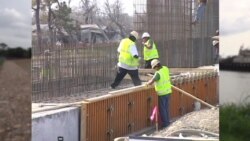On August 29, New Orleans will observe the tenth anniversary of Hurricane Katrina and the subsequent flooding of the low-elevation city.
Levees built by the U.S. Army Corps of Engineers failed to withstand the surge of storm water from the storm. As a result, most of New Orleans was flooded.
After Katrina, the Corps of Engineers replaced the levees that failed with better ones.
In the city's Lower Ninth Ward, Renata and her family continue to work on repairs.
“We are still working on it,” she said, “but we’ve got it livable."
Water gushing from the broken levees flooded most of the Lower Ninth Ward.
While many people rebuilt their homes, there are still many empty lots and ruined structures.
The new levees are built much deeper and much stronger, but many critics of the Corps of Engineers say these are the kind of levees that should have been built in the first place.
“It was the largest engineering failure in history,” said Andy Kopplin, New Orleans’s deputy mayor. “Katrina was a storm that was not bigger than what the levees were built to withstand.”
“I feel a little better about the levees today,” saod Martez Lynch, who lives near the new levee in the Lower Ninth Ward. “I mean the Army Corps of Engineers and everybody who came out to help can only do so much. Mother Nature will take its course if that is what she wants to do.”
But human infrastructure has disrupted nature by reducing wetlands and barrier islands below New Orleans.
Kyle Graham, who works for the Louisiana Coastal Protection And Restoration Authority, said state and federal authorities are working together to restore coastal barriers to help prevent a recurrence of what happened 10 years ago.
“One of the things that both the barrier islands as well as our marshes do is they knock down that storm surge so that when it does hit some of these communities it is not as high as it would be otherwise.”










